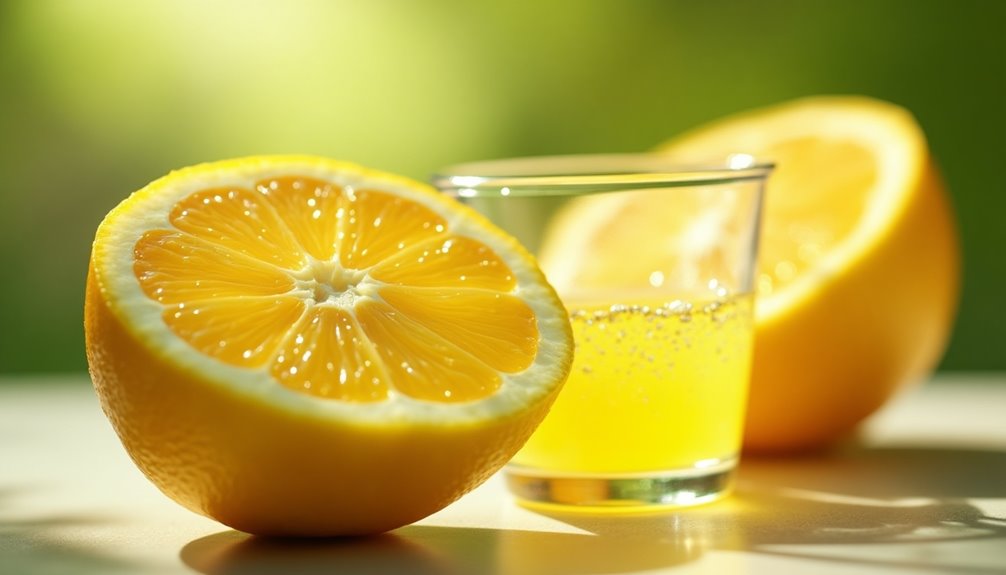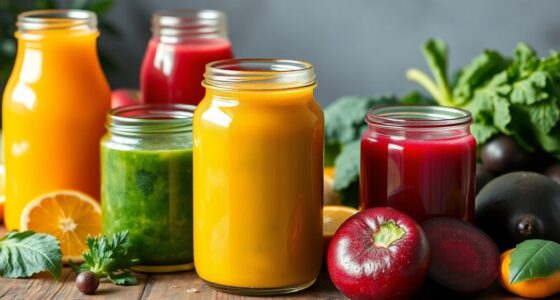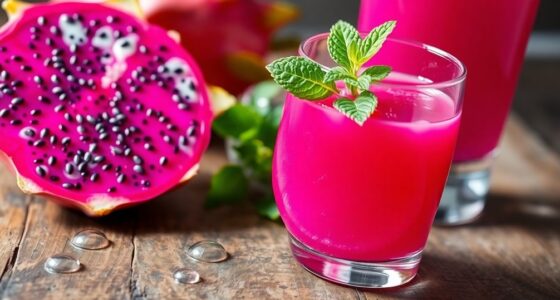When you cut a medium lemon in half, you can expect to get about 1.5 tablespoons of juice. If it's a large lemon, you'll likely squeeze out around 2 tablespoons from that half. Since juice yield can vary based on size and ripeness, it's smart to have a few extra lemons on hand for your recipes. Want to discover more tips on how to maximize your lemon juice for cooking? Keep going!
Key Takeaways
- A half lemon typically yields about 1.5 tablespoons of juice, depending on its size and ripeness.
- Medium lemons produce approximately 3 tablespoons of juice, so half would yield about 1.5 tablespoons.
- Large lemons yield around 4 tablespoons, resulting in about 2 tablespoons of juice from half.
- Juice yield can vary among lemons, so results may differ slightly.
- Always consider purchasing extra lemons to ensure you have enough juice for your recipe.

When you’re cooking or baking, knowing how much juice you can expect from a lemon is essential. The amount of juice in one lemon can vary depending on its size and ripeness, which can affect your recipes significantly. If you’re using a medium lemon, you can typically expect to get about 3 tablespoons of juice. This makes it a handy reference when measuring for your favorite dishes. If you’re in a situation where a recipe calls for a smaller amount, you might wonder how much juice from half a lemon you can expect. Generally, half of a medium lemon yields roughly 1. 5 tablespoons of juice, making it easy to adjust your measurements accordingly. Understanding these conversions not only helps streamline your cooking process but also ensures that your final dish maintains its intended flavor profile.
On the other hand, if you grab a large lemon, you can usually squeeze out around 4 tablespoons, allowing you to adjust your recipes accordingly.
When you're preparing something that calls for a specific amount of lemon juice, it's crucial to have an idea of how many lemons you'll need. For example, if your recipe requires ½ cup of lemon juice, which equals 8 tablespoons, you'll need approximately 3 medium lemons or about 2 large lemons. Knowing this can save you time and frustration in the kitchen, especially when you're in the middle of preparing a meal or dessert.
Lemon yields can fluctuate, so it's wise to keep this in mind while shopping. Larger lemons generally yield more juice than their smaller counterparts, but you can't always guarantee that. If you're unsure about how much juice you'll get from a specific lemon, it might be a good idea to purchase an extra one or two just in case. This way, you won't find yourself running short, which can throw a wrench into your cooking plans.
It's also important to remember that the juice and zest of a lemon can complement each other beautifully in recipes. While you might focus on how much juice is in one lemon, the zest adds a different flavor profile that can enhance your dish.
A medium lemon, with its 3 tablespoons of juice, typically yields enough zest to elevate your recipes as well. If you're making a lemon cake or a vinaigrette, for instance, using both the juice and zest from one or two lemons can bring a refreshing brightness to your dish.
Frequently Asked Questions
How Much Juice Is in a Half Lemon?
When you cut a lemon in half, you can expect to get about 1.5 tablespoons of juice from a medium-sized lemon.
If you're using a larger lemon, you might squeeze out around 2 tablespoons.
Keep in mind that the amount can vary based on the lemon's size and ripeness.
To maximize your yield, roll the lemon on a countertop before cutting it.
This helps to release more juice for your recipes!
How Much of Bottled Lemon Juice Is Equal to 1 Lemon?
When you're craving that zesty burst of lemon in your dish, you might wonder how to capture that brightness with bottled juice.
Generally, about 3 tablespoons of bottled lemon juice equals the juice from one medium lemon. If you're using a large lemon, you can stick with around 2 tablespoons.
Just remember, bottled juice can sometimes lack that fresh, vibrant flavor, so always taste and tweak it to your liking!
Can You Substitute Bottled Lemon Juice for Fresh Lemon Juice?
Yes, you can substitute bottled lemon juice for fresh lemon juice, but you might need to adjust the amount.
Generally, bottled juice has a different flavor intensity, so start with a little less than what the recipe calls for.
Taste as you go to ensure you get the right balance.
Fresh juice offers a vibrant flavor, while bottled is convenient, so choose based on your needs and preferences for the best results.
Is Realemon the Same as Lemon Juice?
When you whip up a lemon meringue pie, you might wonder if Realemon is the same as fresh lemon juice.
While Realemon offers convenience and consistent acidity for baking, it doesn't quite match the bright, fresh flavor of squeezed lemons.
For your pie, using fresh juice can elevate the taste, but if you're in a pinch, Realemon works as a solid substitute.
Just know the flavors might differ slightly.
Conclusion
So, when you're squeezing half a lemon, you're likely getting about 1 to 1.5 tablespoons of juice. Think of it like a treasure hunt; every squeeze uncovers a burst of flavor, just like finding hidden gems along the way. Whether it's brightening up a dish or adding zing to your drink, that little half lemon packs a punch. So, next time you reach for that citrus, remember the adventure of flavor waiting to be discovered!
Cindy thoroughly researches juicing trends, techniques, and recipes to provide readers with practical advice and inspiration. Her writing style is accessible, engaging, and designed to make complex concepts easy to understand. Cindy’s dedication to promoting the advantages of juicing shines through her work, empowering readers to make positive changes in their lives through the simple act of juicing.

















